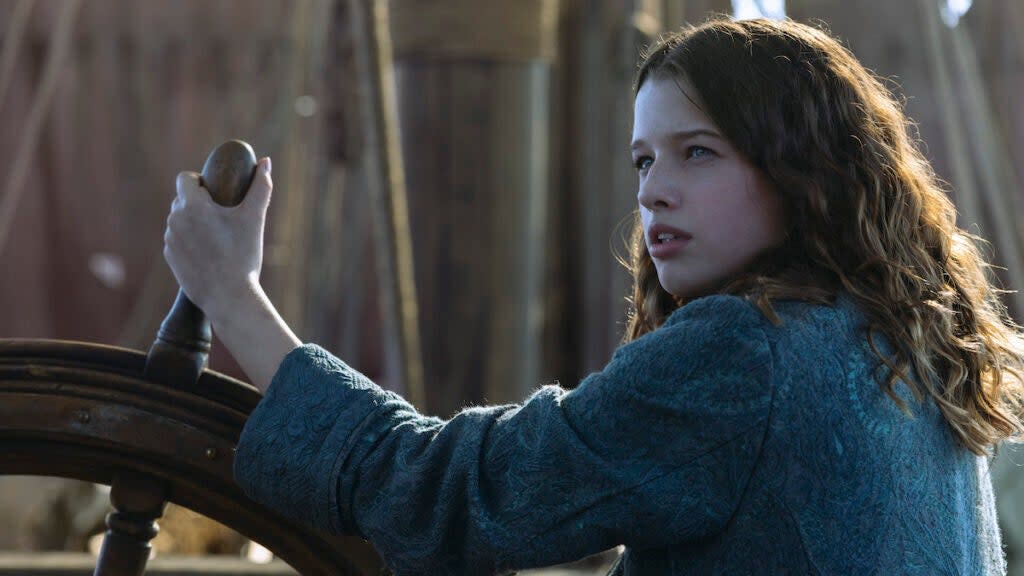‘Peter Pan & Wendy’ Review: David Lowery’s Reimagining of a Children’s Classic Is Refreshing and Wearisome

- Oops!Something went wrong.Please try again later.
As written by J. M. Barrie in his original 1904 play, “Peter Pan, or The Boy Who Wouldn’t Grow Up,” the century-old name Peter Pan has always been synonymous with a severe case of arrested development. More expressly, the fear of adulthood, the immature reluctance towards embracing the responsibilities and pains of being a grown-up, unable to gauge the earned rewards of such hardships.
So what could a 21st-century version of such arrested development look like? One that has something to say to today’s grown-ups both mesmerized and puzzled by a fiery younger generation vastly different than them, and today’s kids, being raised by an unprecedented sense of individuality? With “Peter Pan & Wendy,” soulful auteur David Lowery tries to find an answer with mixed results that’s fascinating and refreshing in parts and somewhat wearisome on the whole.
An expressive voice throughout his wide range of tales, Lowery is the perfect storyteller for this experiment, despite the uneven outcome. He has the right mournful temperament that runs through his filmography, from the grief-soaked supernatural tone poem “A Ghost Story” to the deeply compassionate “Pete’s Dragon,” that is unsubtly about the second chance that outcast rescue animals deserve.
That somber disposition of his, necessary to say a teary goodbye to childhood, charges “Peter Pan & Wendy,” a reimaginating in which Pan is considerably less haughty, Wendy is more crucial to the tale (so much so that the film should have been retitled, “Wendy & Peter Pan”), and the crocodile-fearing villain Captain Hook is afforded a deeper and more complicated backstory that ultimately muddies up Lowery’s intentions.
Also Read:
First Trailer for Disney’s ‘Peter Pan & Wendy’ Promises a Very David Lowery Fairy Tale (Video)
The basic idea is more or less as you remember it in the 1953 original film, a basis for this offshoot written by Lowery and his long-time collaborator Toby Halbrooks. We’re in the early 20th-century London on the eve of her departure for boarding school and Wendy Darling (an entrancing Ever Anderson, both childlike and precocious) is refusing to grow up. Her wish reaches Peter Pan (played by Alexander Molony with innocence and a dose of mischievous arrogance), who shows up in Wendy’s room with the fairy Tinker Bell (Yara Shahidi) to take Wendy and her brothers John (Joshua Pickering) and Michael (Jacobi Jupe) to Neverland, to add them to the ranks of his loyal tribe, The Lost Boys.
After a magical flight, the group are subjected to an attack from Captain Hook (a pensive Jude Law) with the brothers falling as prisoners to Hook’s pirate ship, the Jolly Roger. Throughout the adventure, Wendy meets Indigenous heroine Tiger Lily (Alyssa Wapanatâhk), who becomes a guiding voice and pledges to rescue her brothers before they are killed at Skull Rock.
Lowery once again treats his young audiences as shrewd viewers who deserve multilayered stories, well-developed characters and lush visuals. His “Peter Pan & Wendy” delivers in most of those departments, immediately begging the question why Disney has banished this title exclusively to its streaming platform, instead of giving this reboot—far more imaginatively fashioned than many of the studio’s soulless live-action remakes of the last few years—a chance to flourish on theatrical screens.
While the obvious green screen contours sometimes distract (which could very well be an effect of seeing it on TV), Lowery’s below-the-line collaborators—from Costume Designer Ngila Dickson to Production Designer Jade Healy—jointly bring to life Lowery’s unapologetically big vision with some magic.
The production makes strides for representation too, conjuring up a diverse Neverland that feels much closer to our own world. In addition to the casting of Shahidi as the first Black woman to play Tinker Bell and the indigenous Wapanatâhk as Tiger Lily, “Peter Pan & Wendy” also includes Noah Matthews Matofsky, an actor with Down Syndrome playing a member of the Lost Boys. You wish that Matofsky was given more to do in the story, but his casting still feels like a big step in a children’s classic that previously only made room for the same demographic of actors.
Also Read:
Disney’s ‘Wish’ Trailer Finds Ariana DeBose Wishing Upon a Star (Video)
Where Lowery’s version falters is the portrayal of Hook. Following in the footsteps of a rising trend that aims to give every storybook villain (from “Maleficent” to “Cruella”) a cleansing backstory, “Peter Pan & Wendy” wonders what would have happened if Hook and Pan were actually best friends once upon a time and Hook has valid reasons to hate Pan’s guts? Unsuccessfully tried before by 2015’s horrendous origin film “Pan,” this query, admittedly, strengthens Pan’s character—namely, his flaws and mistakes that Wendy can neither unsee nor stay quiet about until he finally comes of age.
But it also flattens the tale’s overarching enchantment, falsely reinforcing the notion that behind every bad person who wishes to do us harm is a misunderstood person who deserves a second chance. In the name of all fairy tales about good vs. evil—and in acknowledging real-life evil forces who aren’t secretly misunderstood good people—perhaps we can just let villains be villains for a while.
Still, Lowery conjures up some visual delights from his template, swiftly orchestrating various duels and stand-offs between the pirates and the Lost Boys, as well as between Hook and Pan.
His tone is perhaps a little too gloomy, too existential to be appreciated by kids of all ages. But the precocious ones eager to grow up fast might just hold this one close. For those growing up at their own Peter Pan pace, Lowery’s “Peter Pan & Wendy” will be there for them once they are ready for it….if they somehow realize it lives somewhere inside Disney’s bottomless digital neverland, that is.
Also Read:
Layoffs Hit Disney+, Walt Disney Studios Marketing Teams | Exclusive

